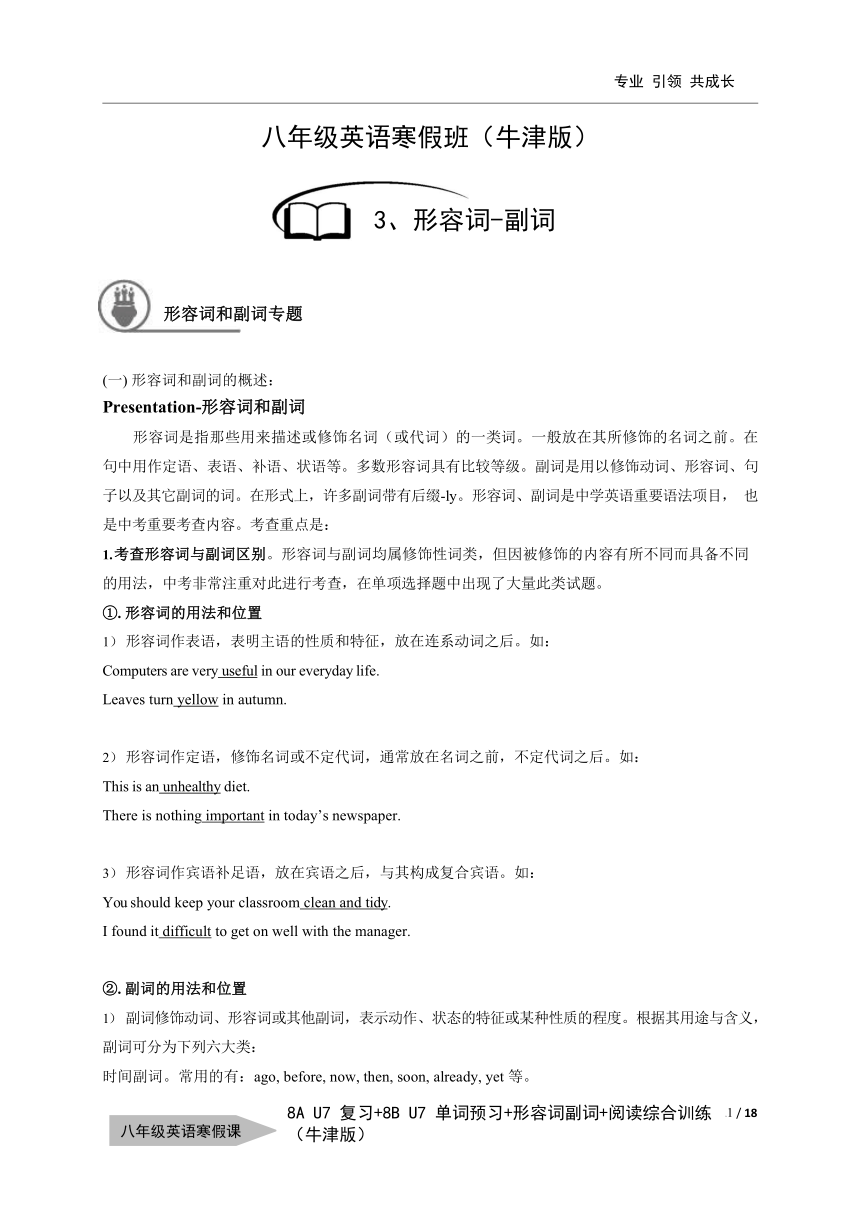
八年级英语寒假班(牛津版) (一) 形容词和副词的概述: Presentation-形容词和副词 形容词是指那些用来描述或修饰名词(或代词)的一类词。一般放在其所修饰的名词之前。在句中用作定语、表语、补语、状语等。多数形容词具有比较等级。副词是用以修饰动词、形容词、句子以及其它副词的词。在形式上,许多副词带有后缀-ly。形容词、副词是中学英语重要语法项目, 也是中考重要考查内容。考查重点是: 考查形容词与副词区别。形容词与副词均属修饰性词类,但因被修饰的内容有所不同而具备不同的用法,中考非常注重对此进行考查,在单项选择题中出现了大量此类试题。 ①. 形容词的用法和位置 形容词作表语,表明主语的性质和特征,放在连系动词之后。如: Computers are very useful in our everyday life. Leaves turn yellow in autumn. 形容词作定语,修饰名词或不定代词,通常放在名词之前,不定代词之后。如: This is an unhealthy diet. There is nothing important in today’s newspaper. 形容词作宾语补足语,放在宾语之后,与其构成复合宾语。如: You should keep your classroom clean and tidy. I found it difficult to get on well with the manager. ②. 副词的用法和位置 副词修饰动词、形容词或其他副词,表示动作、状态的特征或某种性质的程度。根据其用途与含义,副词可分为下列六大类: 时间副词。常用的有:ago, before, now, then, soon, already, yet 等。 地点副词。常用的有:here, there, up, down, above, below, inside, outside 等。疑问副词。常用的有:where, when, why, how 等。 程度副词。常见的有:very, much, so, too, quite, enough 等。 方式副词。多由“形容词+ly”后缀构成。如:carefully, quickly, easily, quietly 等。 频度副词。常用的有:always, often, sometimes, usually, hardly, never 等。 副词在句中主要用作状语。也可充当宾语、表语等。如: It’s snowing heavily outside. (状语,修饰动词) I have never heard such a beautiful voice. (状语,修饰动词) Unluckily, he failed in this physics exam again. (状语,修饰整个句子) He was too excited to say a word. (状语,修饰形容词) Class is over. (表语) The weather here is different from that of Singapore. (定语) 程度副词通常位于被修饰的形容词或副词之前,但 enough 则要放在后面。如: It was much more freezing today than yesterday. He ran so fast that I couldn’t catch up with him. We got up early enough to catch the first bus. 频度副词通常位于行为动词之前,be 动词、助动词和情态动词之后,但一般不放在句末。如: I have never been late or class. You must always work like that. 考查“级”的范围。两个事物进行比较应使用比较级,三个或三个以上事物进行比较应使用最高级。 形容词和副词的比较级和最高级的构成 形容词和副词的比较级和最高级的构成分为三种类型: 1) 在大多数单音节词和少数双音节词的词尾加-er, est。 一般情况在词尾加-er, est。如:hard harder hardest 以字母 e 结尾的只加-r, st。如:large larger largest 以辅音字母+y 结尾的,先改 y 为 i, 再加-er, est。如:healthy healthier healthiest 单元音单辅音结尾的重读闭音节,先双写该辅音,再加-er, est。如:thin thinner thinnest 注:词尾为ow, er, le 结尾的双音节词都采用这种形式。如: narrow narrower narrowest clever cleverer cleverest simple simpler simplest 在多音节和部分双音节的词前加 more, most。另外,由过去分词转化而成的形容词,不论多少个音节都能用这种形式 ... ...
~~ 您好,已阅读到文档的结尾了 ~~